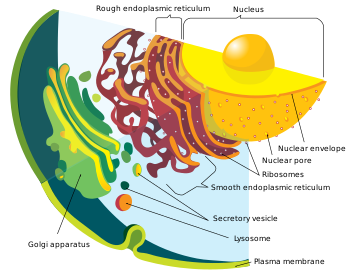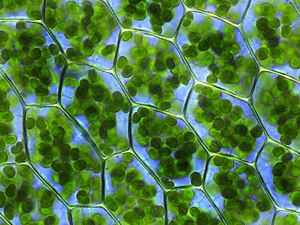Biology, Answering the Big Questions of Life/organelles
| INTERMEDIATE |
Organelles
[edit | edit source]Eukaryotic cells contain many substructures called organelles. These little organs perform different functions inside the cell.
Nucleus
[edit | edit source]
The largest organelle is the nucleus. This is where the information used to run the cell is found.
A dark spot inside a nucleus is called a nucleolus and this is thought to be the location where ribosomal RNA (ribonucleic acid) is made. Some cells have nucleoli and some cells do not.
The nucleus is surrounded by a double membrane. The membrane contains holes called nuclear pores that are used to transport large objects ( such as ribosomes) out of the nucleus.
The endomembrane system
[edit | edit source]
The nucleus works together with a group of organelles that make up what is called the endomembrane system. They are the factories which build the cell.
Ribosomes are small structures found in the cytoplasm which make proteins. When proteins must be inserted into a membrane, or when they must be secreted, then the ribosome will attach to a structure called the rough endoplasmic reticulum where the protein will be made. ( Reticulum means a net.)
The rough endoplasmic reticulum is rough because of the ribosomes on its surface. Proteins made here will travel in small bubbles called vesicles to another organelle called the Golgi apparatus where they are sorted, assembled into larger structures, and sent to different parts of the cell.
The Golgi makes lysosomes which contain digestive enzymes for breaking down food. It also assembles structures that will end up in the plasma membrane.
The smooth endoplasmic reticulum does not contain ribosomes. It is thought to be the site of many chemical processes including the synthesis of lipids.
Vesicles
[edit | edit source]Small round bubbles found in a cell are called vesicles. Some vesicles are simply molecules in transit such as from the Endoplasmic reticulum (ER) to the Golgi, or from the Golgi to the plasma membrane.
Others have special functions such as lysosomes which contain digestive fluids or peroxisomes that contain chemicals to breakdown harmful oxidants in the cell.
Secretory vesicles are used to store chemicals that will be secreted from the cell. A vesicle that is filled with water is called a vacuole. Plants, for example, have large vacuoles in the center of the cell.
Mitochondria
[edit | edit source]
The mitochondria are the powerhouses of the cell. They produce high energy molecules called ATP (Adenosine tri-phosphate) that are used throughout the cell to drive chemical reactions. Mitochondria are the site of aerobic respiration where sugar is broken down in the presence of oxygen to make energy.
Chloroplasts
[edit | edit source]
Chloroplasts are organelles found exclusively in plants and algae. Chloroplasts absorb light and convert it to usable, storable energy for the plant in a process called photosynthesis. This allows plants and algae to be autotrophs - organisms that produce their own food. Chloroplasts primarily use chlorophyll as a pigment to absorb light. Chlorophyll reflects green light, explaining why plants are green. Chloroplasts and photosynthesis are explained in more depth later.
Endosymbiosis
[edit | edit source]Endosymbiosis is a theory that proposes that mitochondria and chloroplasts were, at one point, individual organisms that eventually evolved to be able to live only in a eukaryotic cell. It is proposed that mitochondria and chloroplasts were once prokaryotes that lived symbiotically (in mutual benefit) inside eukaryotes. For example, the precursors to mitochondria would have benefitted from the supply of sugars by the eukaryote, while the eukaryote would have benefitted from ATP. One major piece of evidence supporting this theory is the fact that both mitochondria and chloroplasts have their own DNA and replicate independently from the eukaryotic cell.
Cytoskeleton
[edit | edit source]
The cytoskeleton of a cell is the network of various proteins that maintain the cell's shape. Three major types of fiber exist within the cytoskeleton: microfilaments, intermediate filaments, and microtubules. Microfilaments are the smallest of the three and are made of actin, a major component of muscle cells. Intermediate filaments are larger than microfilaments and are made of a variety of proteins. Microtubules are the largest of the three. Along with providing structure for the cell, they also form cilia and flagella [pictured], which protrude from the cell and are responsible for movement.
Centrosomes and Centrioles
[edit | edit source]
Centrosomes are important organelles for cell division (mitosis) in animals. Each centrosome is made of two centrioles and is responsible for making microtubules, which is especially important for splitting DNA evenly into two daughter cells during cell division.

